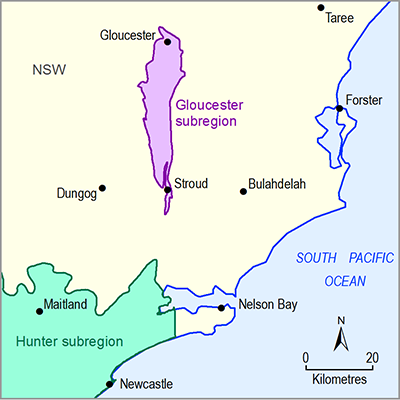The Craven Subgroup (Figure 3 and Figure 4) has five constituent formations, three of which are coal-bearing and the other two conglomeratic. There are nine discrete coal members defined within the subgroup. The Bowens Road Coal Member is the lowermost seam in the Craven Subgroup and recognisable throughout a substantial part of the Gloucester Basin. It is a very dull coal ranging in thickness from less than 1 m in some areas to greater than 12 m north of the Stratford area (Hughes, 1995, p. 424). Around the Bowens Road North Project area (Figure 6a), the Bowens Road Coal Member varies in thickness from 1 to 14 m where it consists of five main coal plies which are dipping to the west (Resource Strategies, 2001, p. 2–1). In the northern part of the Bowens Road North Project area it is relatively flat near the surface and steepens with depth, whereas in the southern project area it is generally steeper (Resource Strategies, 2001, p. 3–3). In the Rocky Hill Coal Project area it consists of six main plies with an average combined net coal thickness of 9.2 m (AGE, 2013, p. 4–45).
Coals below the Bowens Road Coal Member have higher proportions of inherent mineral matter which is often retained during washing, whereas those above are discretely banded with lower inherent mineral matter contents (Hughes, 1995, p. 424).
The Roseville seam is up to 16 m thick with an average thickness of 3.7 m in the Rocky Hill Coal Project area (see Figure 7, Section 1.2.3). Like the overlying Cloverdale Coal Member the coal is interbedded with upward coarsening sandstone and minor siltstone (AGE, 2013, p. 4–45). The Cloverdale Coal Member varies between 5 and 10 m in thickness, consists of variable coal and stone bands, and, according to Hughes (1995, p. 424), is the uppermost seam in the coal measure sequence to show significant thickness over large areas. This banded seam is present over almost all of the eastern margin. In the Rocky Hill Coal Project area it comprises four main plies with an average combined net coal thickness of 7.8 m (AGE, 2013, p. 4–45). The development of the Cloverdale Coal Member represents a considerable time either during tectonic hiatus or a period when contributory channels did not readily flood and only introduced clay and silt-sized sediment into peat swamps (Roberts et al., 1991, p. 186).
The Bindaboo and Deards coal members are part of the Leloma Formation, whereas the Cloverdale and Roseville members are part of the Jilleon Formation. The Bindaboo, Deards, Cloverdale, and Roseville coal members, which were intercepted in the monitoring bore drilling program for AGL’s Stage 1 Gas Field Development, vary in thickness from 3 to 18 m and comprise thin coals interbedded with dark organic siltstones and shale (Parsons Brinckerhoff, 2012, p. 68).

